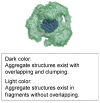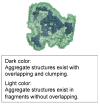Strength Assessment of Water-Glass Sand Mixtures
- PMID: 37998940
- PMCID: PMC10670836
- DOI: 10.3390/gels9110850
Strength Assessment of Water-Glass Sand Mixtures
Abstract
For years, the chemical injection process has aided construction works by increasing the strength and water-sealing efficiency of sandy soil. Despite its growing popularity in projects, such as seismic strengthening and liquefaction mitigation, a unified understanding of how chemically treated soil develops its strength, especially under static conditions, remains elusive. Some studies have proposed that strength is derived from the tensile effects of dilatancy, where shearing of the sandy soil causes expansion, creating tension in the interstitial hydrogel and resulting in negative pressure that consolidates the soil particles. Other studies, however, attribute this strength development to the volumetric shrinkage of the hydrogel, which the authors argue confines and compresses the sandy soil particles. Challenges are encountered with this theory, particularly with respect to the consistency of the volumetric shrinkage measurements and the timing of these measurements in relation to changes in soil strength. The aim of the current research is to shed light on this mechanism by using consolidation drainage triaxial compression (CD) tests to measure the cohesive strength and internal friction angle of chemically enhanced soil. By eliminating the dilatancy-induced negative pressure effects and coupling this with an analysis of the molecular structure of the hydrogel, the present study provides an in-depth look at the strength development mechanism and its durability. This holistic approach not only fills in the existing gaps in the understanding of this mechanism, but also paves the way for optimized construction techniques.
Keywords: chemical injection; consolidation drainage triaxial compression test; hydrogel; sand-gel; small angle X-ray scattering test.
Conflict of interest statement
The authors declare no conflict of interest. In this paper, Osaka Bousui Construction Co. Ltd., of which the first author is a member, mainly conducted the physical and mechanical investigations, and Fuji Chemical Co. Ltd., of which the second author is a member, mainly conducted the chemical investigations. The last author, Shibaura Institute of Technology, summarized these studies. The paper reflects the views of the scientists and not the company.
Figures























References
-
- Karol R.H. Chemical Grouting and Soil Stabilization. 3rd ed. CRC Press; Boca Raton, FL, USA: 2003. Revised and expanded.
-
- Varol A., Dalgıç S. Grouting applications in the Istanbul metro, Turkey. Tunn. Undergr. Space Technol. 2006;21:602–612. doi: 10.1016/j.tust.2005.11.002. - DOI
-
- Kazemian S., Huat B.B., Arun P., Barghchi M. A review of stabilization of soft soils by injection of chemical grouting. Aust. J. Basic Appl. Sci. 2010;4:5862–5868.
-
- Anagnostopoulos C.A., Papaliangas T., Manolopoulou S., Dimopoulos T. Physical and mechanical properties of chemically grouted sand. Tunn. Undergr. Space Technol. 2011;26:718–724. doi: 10.1016/j.tust.2011.05.006. - DOI
-
- Liang Y., Sui W., Qi J. Experimental investigation on chemical grouting of inclined fracture to control sand and water flow. Tunn. Undergr. Space Technol. 2019;83:82–90. doi: 10.1016/j.tust.2018.09.038. - DOI
LinkOut - more resources
Full Text Sources

